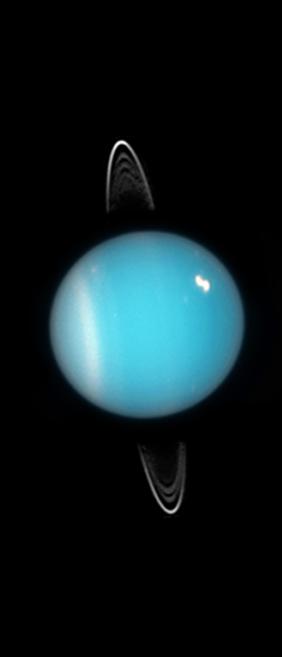Glossary term: Uranus
Description: Uranus is the seventh farthest planet from the Sun. It is an ice giant with a radius of about 25 thousand kilometers (km), roughly four times the radius of the Earth. Uranus has a mass of 14.5 times the Earth's mass, and a solid rock core surrounded by a layer of high-pressure water, methane, and ammonia. In the early outer Solar System these chemicals were frozen. The young Uranus accreted these "ices", hence the name "ice giant". Uranus's outer atmosphere is a thick, puffy layer of hydrogen and helium. Its rotational axis is tilted by more than 90 degrees relative to the orbital plane. Uranus has a ring system.
Its typical distance from the Sun is about 2.9 billion km, around 19 astronomical units (Earth–Sun distances). Uranus takes around 84 years to complete one orbit. It has over 25 known moons or natural satellites.
Uranus is barely visible to the naked eye under good conditions and as a result it was not identified as a planet before the modern era. It was identified as such in 1781 by William Herschel. Thus, it was the first planet to be found since antiquity. Uranus is named after the Greek god of the sky.
Related Terms:
See this term in other languages
Term and definition status: This term and its definition have been approved by a research astronomer and a teacher
The OAE Multilingual Glossary is a project of the IAU Office of Astronomy for Education (OAE) in collaboration with the IAU Office of Astronomy Outreach (OAO). The terms and definitions were chosen, written and reviewed by a collective effort from the OAE, the OAE Centers and Nodes, the OAE National Astronomy Education Coordinators (NAECs) and other volunteers. You can find a full list of credits here. All glossary terms and their definitions are released under a Creative Commons CC BY-4.0 license and should be credited to "IAU OAE".
Related Media
Uranus in natural colours
Credit: NASA/JPL-Caltech credit link
License: PD Public Domain icons
Uranus with rings
Credit: NASA, ESA, and M. Showalter (SETI Institute) credit link
License: PD Public Domain icons










